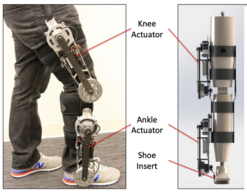Lower Limb Powered Orthosis with Low Ratio Actuation
TECHNOLOGY NUMBER: 2021-178

OVERVIEW
A powered knee-ankle device which produces a high torque without a high-ratio transmission- Uses low ratio transmission that allows patients to actively contribute to their joint movements
- Employs frameless components and lightweight materials to aid mobility and ease of use
BACKGROUND
Physical training is often needed for patients to relearn how to walk after a stroke, though finite medical resources limit the frequency and availability of those interventions. To address these shortcomings, researchers have investigated powered lower-limb rehabilitation orthoses to relieve the repetitive and physically tasking duties of therapists, as well as to improve patient recovery efficacy. Currently, most lower limb rehabilitation orthoses are stationary and only available in a small number of hospitals, due to their high cost and large size. Therefore, personal mobile lower-limb orthoses that can be used in the clinic or at home would be desirable for purposes of rehabilitating this patient group. Existing mobile powered, lower-limb orthosis devices suffer from limitations such as output torque, complex system architecture, bulky size, and limited force control bandwidth. Due to the high torque requirements of lower-limb joints, a need exists to increase the torque density of powered orthoses to provide enough output torque within an acceptable weight.
INNOVATION
Researchers have invented an orthosis which utilizes a novel, powered knee-ankle device that produces a high output torque without a high-ratio transmission while providing precise torque control and backdrivability without series elastic components. The modular actuator of the orthosis is designed with a torque dense motor and a custom low-ratio transmission (24:1) to provide mechanical transparency to the user, allowing them to actively contribute to their joint kinematics during gait training. The 4.88 kg orthosis utilizes frameless components and light materials, such as aluminum alloy and carbon fiber, to reduce its mass. A human subject experiment demonstrates accurate torque control with high output torque during stance and low backdrive torque during swing at fast walking speeds. Results of experiments using the device confirm that high torque output during stance phase and low backdrive torque during swing phase can be achieved without using a clutch or variable transmission. The distributed low-ratio transmission is designed to reduce the mechanical impedance and allow the user to easily move their joints. Overall, this device reveals that backdrivability, precise torque control, high torque output, and light weight can be achieved in a powered orthosis without the high cost and complexity of variable transmissions, clutches, and/or series elastic components.